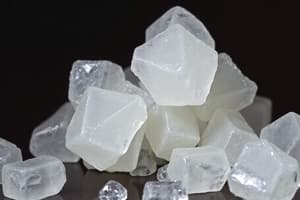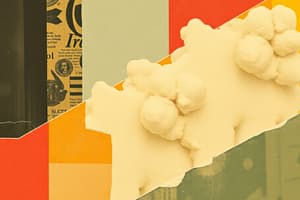Podcast
Questions and Answers
[Blank] are composed of carbon, hydrogen, and oxygen and make up about 70-80% of an animal's diet.
[Blank] are composed of carbon, hydrogen, and oxygen and make up about 70-80% of an animal's diet.
Carbohydrates
[Blank] carbohydrates include monosaccharides and disaccharides, which are single and double sugars, respectively.
[Blank] carbohydrates include monosaccharides and disaccharides, which are single and double sugars, respectively.
Simple
[Blank] carbohydrates, such as polysaccharides, consist of many sugars and provide a more sustained form of energy.
[Blank] carbohydrates, such as polysaccharides, consist of many sugars and provide a more sustained form of energy.
Complex
[Blank], also known as dextrose or blood sugar, is a primary fuel for the body and is found in all disaccharides and polysaccharides.
[Blank], also known as dextrose or blood sugar, is a primary fuel for the body and is found in all disaccharides and polysaccharides.
[Blank], or fruit sugar, is found in fruit, honey, and syrup and is converted to glucose in the body for energy use.
[Blank], or fruit sugar, is found in fruit, honey, and syrup and is converted to glucose in the body for energy use.
[Blank] is a monosaccharide found in milk, and converts to glucose in the body, and is also found in combination with lipids in nervous tissue.
[Blank] is a monosaccharide found in milk, and converts to glucose in the body, and is also found in combination with lipids in nervous tissue.
[Blank], commonly known as table sugar, is a disaccharide composed of glucose and fructose and refined from sugar beets and cane.
[Blank], commonly known as table sugar, is a disaccharide composed of glucose and fructose and refined from sugar beets and cane.
[Blank], or milk sugar, is a disaccharide made of glucose and galactose, and its intolerance results from a missing digestive enzyme needed to absorb it.
[Blank], or milk sugar, is a disaccharide made of glucose and galactose, and its intolerance results from a missing digestive enzyme needed to absorb it.
[Blank], known as malt sugar, consists of glucose + glucose and is found in germinating seeds and fermentation processes to produce malted beverages.
[Blank], known as malt sugar, consists of glucose + glucose and is found in germinating seeds and fermentation processes to produce malted beverages.
[Blank] is a polysaccharide that consists of long chains of glucose found in animals, and is stored in the liver and muscles.
[Blank] is a polysaccharide that consists of long chains of glucose found in animals, and is stored in the liver and muscles.
[Blank] are polysaccharides found in plants, particularly in cereal grains, legumes, and root vegetables.
[Blank] are polysaccharides found in plants, particularly in cereal grains, legumes, and root vegetables.
[Blank], consisting mostly of indigestible carbohydrates like lignin, is a component of plant cell walls and is classified by its solubility in water.
[Blank], consisting mostly of indigestible carbohydrates like lignin, is a component of plant cell walls and is classified by its solubility in water.
[Blank] fiber is non-viscous and includes substances such as cellulose and lignin.
[Blank] fiber is non-viscous and includes substances such as cellulose and lignin.
[Blank] fiber is viscous and fermentable, exemplified by pectins, and can help regulate blood sugar levels.
[Blank] fiber is viscous and fermentable, exemplified by pectins, and can help regulate blood sugar levels.
Soluble carbohydrates, or [Blank], undergo enzymatic digestion and are broken down into hexoses, primarily in monogastric animals.
Soluble carbohydrates, or [Blank], undergo enzymatic digestion and are broken down into hexoses, primarily in monogastric animals.
Carbohydrate digestion begins in the mouth with the secretion of [Blank] that initiates the hydrolysis of starch during mastication.
Carbohydrate digestion begins in the mouth with the secretion of [Blank] that initiates the hydrolysis of starch during mastication.
Carbohydrate digestion temporarily halts in the [Blank] due to high acidity that inactivates salivary α-amylase.
Carbohydrate digestion temporarily halts in the [Blank] due to high acidity that inactivates salivary α-amylase.
Further carbohydrate digestion occurs in the [Blank] via pancreatic enzymes, including pancreatic α-amylase, and intestinal enzymes like sucrase and lactase.
Further carbohydrate digestion occurs in the [Blank] via pancreatic enzymes, including pancreatic α-amylase, and intestinal enzymes like sucrase and lactase.
Pancreatic α-amylase functions to degrade dextrins further into a mixture of [Blank], iso______, and α-limit dextrin.
Pancreatic α-amylase functions to degrade dextrins further into a mixture of [Blank], iso______, and α-limit dextrin.
[Blank] enzymes, located in the brush-border membrane, are responsible for the final phase of carbohydrate digestion, breaking down remaining disaccharides into monosaccharides.
[Blank] enzymes, located in the brush-border membrane, are responsible for the final phase of carbohydrate digestion, breaking down remaining disaccharides into monosaccharides.
End products of carbohydrate digestion—glucose, fructose, and galactose—are readily absorbed through the intestinal ______ cells into the bloodstream.
End products of carbohydrate digestion—glucose, fructose, and galactose—are readily absorbed through the intestinal ______ cells into the bloodstream.
Carbohydrates are absorbed as ______ from the intestinal lumen through active and facilitative transport mechanisms.
Carbohydrates are absorbed as ______ from the intestinal lumen through active and facilitative transport mechanisms.
[Blank] transport allows glucose and galactose to move across the brush border membrane of mucosal cells against a concentration gradient.
[Blank] transport allows glucose and galactose to move across the brush border membrane of mucosal cells against a concentration gradient.
The free energy required for active transport is obtained from the hydrolysis of ATP linked to a ______ pump that expels Na+ from the cell in exchange for K+.
The free energy required for active transport is obtained from the hydrolysis of ATP linked to a ______ pump that expels Na+ from the cell in exchange for K+.
[Blank] transport enables fructose and mannose to be transported across the brush border independently of sodium, using specific glucose transporters like GLUT-5.
[Blank] transport enables fructose and mannose to be transported across the brush border independently of sodium, using specific glucose transporters like GLUT-5.
The sodium-independent transporter, [Blank], facilitates transporting sugars out of the mucosal cells, entering the portal circulation and being transported to the liver.
The sodium-independent transporter, [Blank], facilitates transporting sugars out of the mucosal cells, entering the portal circulation and being transported to the liver.
The major portion of a ruminant's diet consists of cellulose, hemicellulose, and ______, which are complex carbohydrates.
The major portion of a ruminant's diet consists of cellulose, hemicellulose, and ______, which are complex carbohydrates.
Ruminant carbohydrate digestion occurs through ______ fermentation in the rumen, involving enzymes secreted by rumen microbes.
Ruminant carbohydrate digestion occurs through ______ fermentation in the rumen, involving enzymes secreted by rumen microbes.
In ruminants, plant material is fermented into simple sugars utilized by microbes, which produce ______, heat, and volatile fatty acids (VFAs).
In ruminants, plant material is fermented into simple sugars utilized by microbes, which produce ______, heat, and volatile fatty acids (VFAs).
The composition of VFAs in the rumen includes acetic acid (______%), propionic acid (15–20%), and butyric acid (10–15%).
The composition of VFAs in the rumen includes acetic acid (______%), propionic acid (15–20%), and butyric acid (10–15%).
The composition of gases in the rumen consists mainly of carbon dioxide (______%), methane (22%), and hydrogen (2%).
The composition of gases in the rumen consists mainly of carbon dioxide (______%), methane (22%), and hydrogen (2%).
[Blank] bacteria are a type of cellulolytic bacteria which produce cellulase and produce mainly acetate as their primary substance of cellulose.
[Blank] bacteria are a type of cellulolytic bacteria which produce cellulase and produce mainly acetate as their primary substance of cellulose.
[Blank] bacteria are a type of bacteria that digest starches and sugars and prefer pH 5-6.
[Blank] bacteria are a type of bacteria that digest starches and sugars and prefer pH 5-6.
The ______ is responsible for secretion of digestive enzymes, digestive secretions from pancreas and liver and further digestion of carbohydrates.
The ______ is responsible for secretion of digestive enzymes, digestive secretions from pancreas and liver and further digestion of carbohydrates.
The ______ & Large Intestine's bacterial population ferments the unabsorbed products of digestion.
The ______ & Large Intestine's bacterial population ferments the unabsorbed products of digestion.
The α-limit ______ are small oligosaccharides containing 3 to 5 glucose units.
The α-limit ______ are small oligosaccharides containing 3 to 5 glucose units.
______ bacteria use plant fiber (cellulose) as a substrate fermented.
______ bacteria use plant fiber (cellulose) as a substrate fermented.
______ bacteria use plant fibre (pectins) as substrate fermented.
______ bacteria use plant fibre (pectins) as substrate fermented.
______ bacteria use plant fibre (hemi-cellulose) as substrate fermented.
______ bacteria use plant fibre (hemi-cellulose) as substrate fermented.
______ bacteria use starch as substrate fermented.
______ bacteria use starch as substrate fermented.
In carbohydrate digestion within monogastric animals, the breakdown of Nitrogen-Free Extract (NFE) occurs predominantly in the ______.
In carbohydrate digestion within monogastric animals, the breakdown of Nitrogen-Free Extract (NFE) occurs predominantly in the ______.
In ruminants, the digestion of carbohydrates involves microbial ______ in the rumen, which breaks down plant material.
In ruminants, the digestion of carbohydrates involves microbial ______ in the rumen, which breaks down plant material.
The digestion of carbohydrates begins in the mouth with the secretion of ______ from the salivary glands, initiating the hydrolysis of starch.
The digestion of carbohydrates begins in the mouth with the secretion of ______ from the salivary glands, initiating the hydrolysis of starch.
During the active transport of monosaccharides, the transport of glucose and galactose across the brush border membrane requires a specific transport protein and the presence of ______ ions.
During the active transport of monosaccharides, the transport of glucose and galactose across the brush border membrane requires a specific transport protein and the presence of ______ ions.
Unlike insoluble fibers, ______ fibers are viscous, fermentable, and include substances like pectins.
Unlike insoluble fibers, ______ fibers are viscous, fermentable, and include substances like pectins.
Flashcards
Carbohydrates
Carbohydrates
Organic compounds composed of carbon, hydrogen and oxygen, with the formula (CH₂O)n. They are essential energy-providing nutrients for animals.
Carbohydrate Types
Carbohydrate Types
Carbohydrates are classified into two main groups: simple and complex.
Monosaccharides
Monosaccharides
These are the simplest form of carbohydrates, consisting of single sugar molecules.
Glucose
Glucose
Signup and view all the flashcards
Fructose
Fructose
Signup and view all the flashcards
Galactose
Galactose
Signup and view all the flashcards
Disaccharides
Disaccharides
Signup and view all the flashcards
Sucrose
Sucrose
Signup and view all the flashcards
Lactose
Lactose
Signup and view all the flashcards
Maltose
Maltose
Signup and view all the flashcards
Polysaccharides
Polysaccharides
Signup and view all the flashcards
Glycogen
Glycogen
Signup and view all the flashcards
Starch
Starch
Signup and view all the flashcards
Fiber
Fiber
Signup and view all the flashcards
Cellulose
Cellulose
Signup and view all the flashcards
NFE
NFE
Signup and view all the flashcards
Carbohydrate Digestion in the Mouth
Carbohydrate Digestion in the Mouth
Signup and view all the flashcards
Carbohydrate Digestion in the Stomach
Carbohydrate Digestion in the Stomach
Signup and view all the flashcards
Carbohydrate Digestion in the Intestine
Carbohydrate Digestion in the Intestine
Signup and view all the flashcards
Pancreatic α-amylase
Pancreatic α-amylase
Signup and view all the flashcards
Sucrase
Sucrase
Signup and view all the flashcards
Maltase
Maltase
Signup and view all the flashcards
Lactase
Lactase
Signup and view all the flashcards
End Products of Carbohydrate Digestion
End Products of Carbohydrate Digestion
Signup and view all the flashcards
Active Transport
Active Transport
Signup and view all the flashcards
Facilitative Transport
Facilitative Transport
Signup and view all the flashcards
Sodium-dependent Glucose Transporter (SGLT1)
Sodium-dependent Glucose Transporter (SGLT1)
Signup and view all the flashcards
GLUT-2
GLUT-2
Signup and view all the flashcards
GLUT-5
GLUT-5
Signup and view all the flashcards
Carbohydrate Digestion (Ruminants)
Carbohydrate Digestion (Ruminants)
Signup and view all the flashcards
Ruminant Digestion Site
Ruminant Digestion Site
Signup and view all the flashcards
Volatile Fatty Acids (VFAs)
Volatile Fatty Acids (VFAs)
Signup and view all the flashcards
Microbial Populations - Substrate fermented
Microbial Populations - Substrate fermented
Signup and view all the flashcards
Cellulolytic Bacteria
Cellulolytic Bacteria
Signup and view all the flashcards
Amylolytic Bacteria
Amylolytic Bacteria
Signup and view all the flashcards
Small Intestine Function
Small Intestine Function
Signup and view all the flashcards
Large Intestine Function
Large Intestine Function
Signup and view all the flashcards
Study Notes
Carbohydrates
- Carbohydrates are composed of carbon, hydrogen, and oxygen, represented by the formula (CH2O)n.
- They provide energy.
- They should make up about 70-80% of an animal's diet and must be provided daily.
Carbohydrate Types
- Simple carbohydrates include monosaccharides (single sugars) and disaccharides (double sugars).
- Complex carbohydrates are polysaccharides (many sugars).
Monosaccharides
- Simple carbohydrates include hexoses (six-carbon sugars) and pentoses (five-carbon sugars).
- Glucose, fructose, galactose, and mannose are examples with the formula C6H12O6.
Glucose
- Glucose, also known as "dextrose" or "blood sugar," is a primary fuel source for the body.
- Found in all disaccharides and polysaccharides.
- Only fructose and sucrose are sweeter than glucose.
- In nature it is found in combination with other compounds.
Fructose
- Fructose, known as "fruit sugar," is found in fruit, honey, and syrup.
- It converts to glucose in the body.
Galactose
- Galactose forms part of lactose and is found in milk.
- It converts to glucose in the body.
- Galactose is found in combination with lipids in nervous tissue.
Disaccharides
- Simple carbohydrates include sucrose, maltose and lactose
Sucrose
- Sucrose is known as table sugar
- Made up of glucose plus fructose
- Sucrose is refined from sugar beets and cane
Lactose
- Lactose is found in milk
- Made up of glucose and galactose
- Lactose intolerance is when someone is missing the digestive enzyme to split lactose into monosaccharides which are then absorbed
Maltose
- Maltose is also known as malt sugar
- It is made up of glucose and glucose
- Maltose is found in germinating seeds
- Used in fermentation to produce malted beverages
Polysaccharides
- Complex carbohydrates include glycogen, starches, and fibers.
Glycogen
- Glycogen consists of long chains of glucose found in animals.
- It is stored in the liver and muscles.
- It helps maintain blood glucose levels and serves as a quick energy source, lasting about 12 hours, especially during exercise.
Starch
- Starch is composed of long chains of glucose found in plants.
- It is found in cereal grains, legumes, and root vegetables.
Fiber
- Fiber consists of mostly indigestible carbohydrates like lignin.
- It is a component of plant cell walls.
- Fiber is classified based on its solubility in water.
- It is abundant in wholegrains, legumes, and fruits.
Fiber Types
- Insoluble fiber is non-viscous with examples including cellulose and lignin.
- Soluble fiber is viscous and fermentable with examples including pectins.
Carbohydrate Digestion in Monogastrics
- NFE refers to soluble carbohydrates like starches and sugars.
- Digestion involves enzymatic breakdown into hexoses such as glucose.
- This happens in monogastric animals, with primary breakdown in the small intestine.
Digestion in the Mouth
- Digestion begins here
- Salivary glands secrete α-amylase (ptyalin) to hydrolyze starches.
- During mastication, salivary α-amylase acts briefly on dietary starch, randomly breaking α-(1 → 4) bonds, hydrolyzing starch into dextrins.
Digestion in the Stomach
- Carbohydrate digestion halts temporarily in the stomach.
- This is because the high acidity inactivates salivary α-amylase.
Digestion in the Intestine
- Further digestion of carbohydrates occurs in the small intestine, aided by pancreatic enzymes.
- Involves digestion due to pancreatic α-amylase.
- Also involves intestinal enzymes such as sucrase, maltase, lactase, and isomaltase.
Digestion due to Pancreatic α-amylase
- Function is to degrade dextrins further into maltose, isomaltose, and α-limit dextrin.
- α-limit dextrins are short oligosaccharides consisting of 3 to 5 glucose units.
Digestion due to Intestinal Enzymes
- Enzymes for the final phase of carbohydrate digestion are in the brush-border membrane.
- Maltase breaks down maltose into glucose.
- Isomaltase breaks down isomaltose into glucose.
- Sucrase breaks down sucrose into glucose and fructose.
- Lactase breaks down lactose into glucose and galactose.
- Dextrinase breaks down α-limit dextrin into glucose and maltose.
End Products of Carbohydrate Digestion
- Glucose, fructose, and galactose are readily absorbed through intestinal mucosal cells into the bloodstream.
Absorption of Carbohydrates
- Carbohydrates are absorbed as monosaccharides from the intestinal lumen.
- Absorption relies on active transport and facilitative transport.
- Active transport moves against a concentration gradient from low to high.
- Facilitative transport moves with the concentration gradient from high to low.
Active Transport
- The transport of glucose and galactose across the brush border membrane of mucosal cells relies on active transport.
- Key features include energy requirement, specific transport proteins, and the presence of sodium ions.
- A sodium-dependent glucose transporter (SGLT-1) binds both glucose and Na+ at separate sites, transporting them across the plasma membrane of the intestinal cell.
- Sodium is transported down its concentration gradient (higher to lower), glucose then moves against its concentration gradient at the same time.
- This active transport requires free energy from the hydrolysis of ATP, linked to a sodium pump that expels Na+ from the cell in exchange for K+.
Facilitative Transport
- Fructose and mannose are transported across the brush border by a Na+-independent facilitative diffusion process, requiring a specific glucose transporter, GLUT-5.
- Glucose and galactose can also use it if the concentration gradient is favorable.
Carbohydrate Transport
- GLUT-2, a sodium-independent transporter, facilitates sugar transport out of mucosal cells into the portal circulation for delivery to the liver.
Carbohydrate Digestion in Ruminants
- The majority of a ruminant’s diet includes cellulose, hemicellulose, and lignin.
- Enzymes secreted by rumen microbes break down complex carbohydrates.
- VFAs and gases are produced
Carbohydrate Digestion in Ruminants
- Digestion occurs through microbial fermentation in the rumen.
- Plant material is fermented into simple sugars.
- Microbes utilize these simple sugars and produce waste products.
- Waste includes gases, heat, and VFAs (volatile fatty acids).
- Ratios depend on the kind of diet consumed.
Composition of VFAs in the Rumen
- Acetic acid: 60-70%
- Propionic acid: 15-20%
- Butyric acid: 10-15%
Compostition of Gases in the Rumen
- Carbon dioxide: 76%
- Methane: 22%
- Hydrogen: 2%
- Small amounts of oxygen and nitrogen from ingested air.
- VFAs get absorbed straight from the rumen, reticulum, and abomasum.
Microbial Populations
- Cellulolytic bacteria ferment plant fiber, particularly cellulose, producing cellulase.
- Acetate with some propionate is their main product
- They thrive at pH 6-7 and are most common in animals fed roughage diets.
- Pectinolytic bacteria ferment pectins.
- Hemicellulolytic bacteria ferment hemicellulose.
- Amyolytic bacteria digest starches and sugars, preferring pH 5-6.
- They produce mainly propionate but sometimes lactate.
- This bacteria predominates in animals fed grain diets.
- Rapid changes to grain diets can cause lactic acidosis and rapidly decrease pH.
- An example is Streptococcus bovis.
- Ureolytic bacteria will ferment urea
- Proteolytic bacteria breaks down proteins
The Small Intestine
- Secretes digestive enzymes, receives digestive secretions from the pancreas and liver, and further digests carbohydrates.
- It also absorbs water, minerals, amino acids, glucose, and fatty acids.
The Large Intestine
- Also known as the Caecum
- The bacterial population ferments unabsorbed products of digestion.
- It absorbs water and VFA, and forms faeces.
Studying That Suits You
Use AI to generate personalized quizzes and flashcards to suit your learning preferences.




